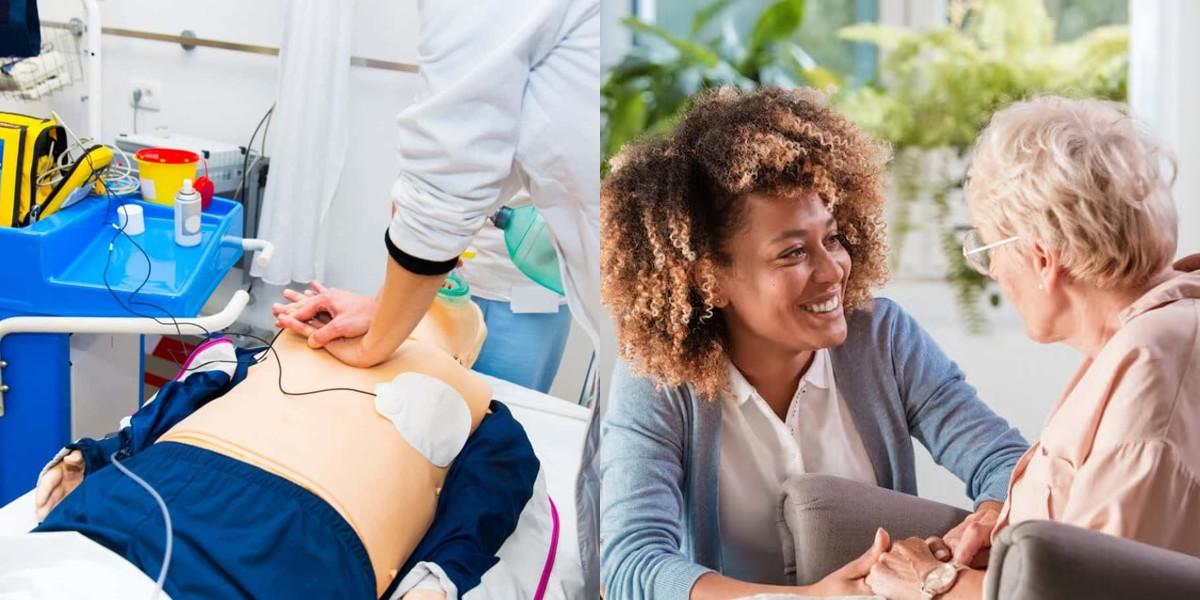ACLS vs Caregiver
SearchHome Health Aide
classes near 43215

Key Points:
- ACLS (Advanced Cardiac Life Support) providers specialize in emergency cardiac care, while caregivers assist with daily activities for the elderly or disabled.
- ACLS providers generally earn higher salaries and work in hospitals, whereas caregivers often work in home healthcare or assisted living settings.
- ACLS training is usually in-person, longer, and more costly compared to caregiver training, which can be in-person or online.
Explore the key differences between ACLS providers and caregivers, from job roles and salary expectations to training requirements and work settings. Understand which healthcare career suits your goals and interests in this comprehensive guide.
What Do ACLS Providers and Caregivers Do?
ACLS Providers are trained for emergencies involving cardiac arrest, strokes, and other urgent conditions. Their skills include performing CPR, administering life-saving medications, and managing airways. They work primarily in hospitals and emergency settings, where their expertise in cardiovascular emergencies is essential.
Caregivers support individuals who need assistance with daily activities due to age, disability, or illness. Caregivers often work in nursing homes, private residences, or assisted living facilities, helping clients with tasks like bathing, dressing, and meal preparation, as well as providing companionship and emotional support.
Key Differences Between ACLS Providers and Caregivers
Scope of Practice
- ACLS Providers: Focus on advanced cardiac care, with specialized training in life-saving interventions like defibrillation and EKG interpretation.
- Caregivers: Offer a broader range of support, helping with daily tasks and maintaining client well-being.
Work Setting
- ACLS Providers: Typically found in hospitals, emergency rooms, or clinics.
- Caregivers: Work in diverse settings, including private homes, nursing facilities, and assisted living centers.
Team Collaboration
- ACLS Providers: Work closely with a team of healthcare professionals to manage cardiac emergencies.
- Caregivers: Often work independently, although they may be part of a team depending on the care setting.
Get courses selected just for you
Try our powerful search engine
Job Description
- ACLS Providers: Their main role involves managing cardiac emergencies through advanced techniques like CPR, medication administration, and airway management, working alongside other healthcare professionals.
- Caregivers: Focus on aiding clients with daily tasks, including hygiene, meals, medication reminders, and transportation, contributing significantly to clients’ quality of life.
Education and Training Requirements
- ACLS Providers: Require a Basic Life Support (BLS) certification as a prerequisite for ACLS training, which includes both classroom instruction and hands-on practice. ACLS courses, typically provided by organizations like the American Heart Association, emphasize emergency cardiac care.
- Caregivers: Educational requirements vary by state. Some positions require only a high school diploma, while others demand formal training or certification. Training can be obtained through on-the-job experiences or certified programs.
Career Outlook and Salary
- ACLS Providers: With an aging population, demand for ACLS providers is on the rise. The median annual salary for EMTs and paramedics, often ACLS-certified, was $53,180 as of May 2023 (BLS).
- Caregivers: Expected to be in high demand due to the growing elderly population, with a median annual salary of $33,530 for personal care aides (BLS, May 2023).
Final Thoughts
Both ACLS and caregiving careers provide opportunities to make a meaningful impact on patient lives. ACLS is ideal for those drawn to fast-paced, emergency settings, while caregiving may suit those who find fulfillment in long-term patient relationships. Carefully consider your interests and goals to choose the healthcare path that resonates with your passion for helping others.
Explore Dreambound Programs Near You:

Stephanie Dayak is the go-to person for everything related to automation and integrations at Dreambound. As a Certified Tax Technician turned tech whiz, her sharp eye for detail and passion for efficiency become evident in every project she undertakes. When not solving tech puzzles, she's out exploring the local food scene, cozying up with her dogs, or plugged into a thought-provoking podcast. She's an ardent believer in mixing fun with functionality!
